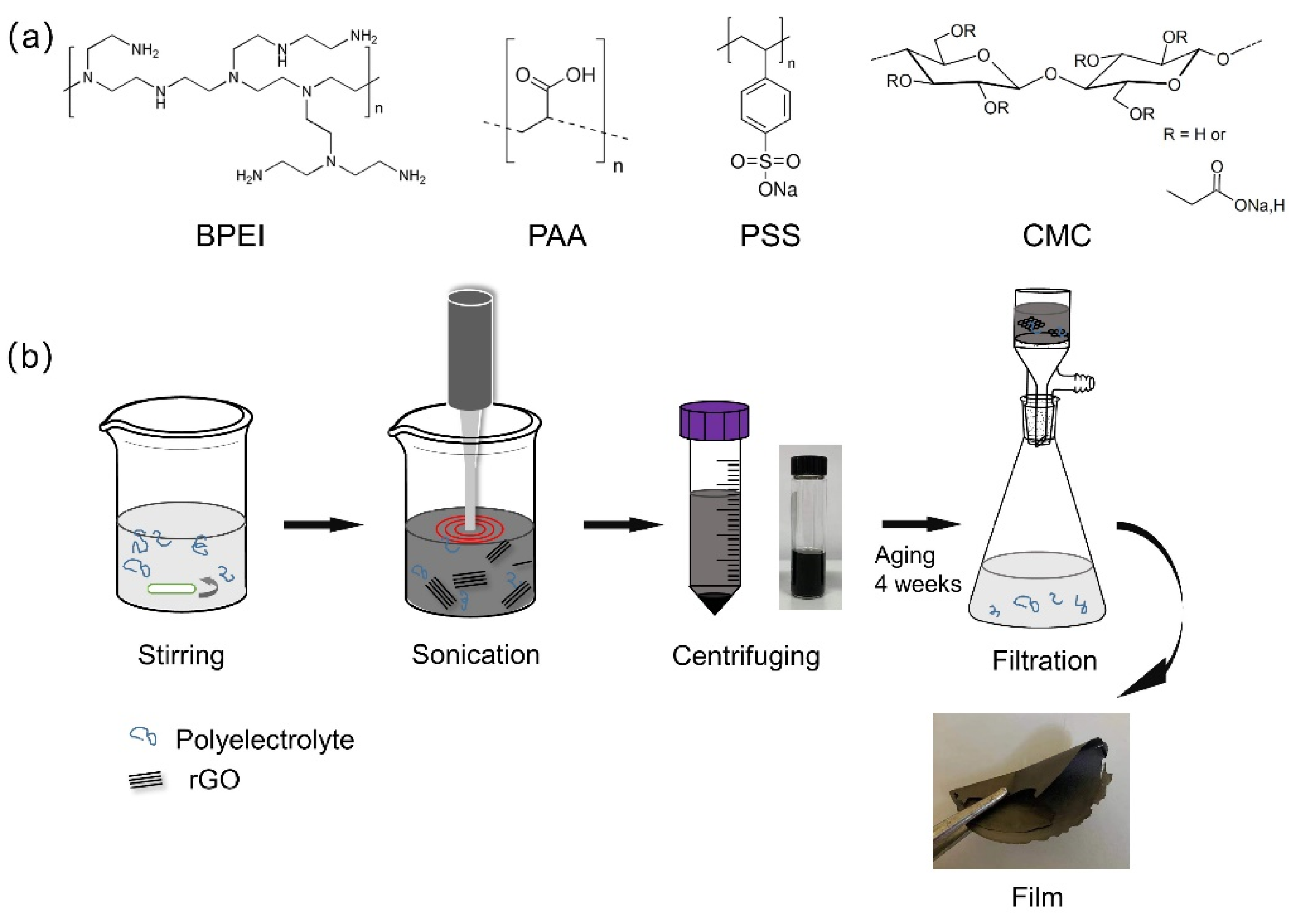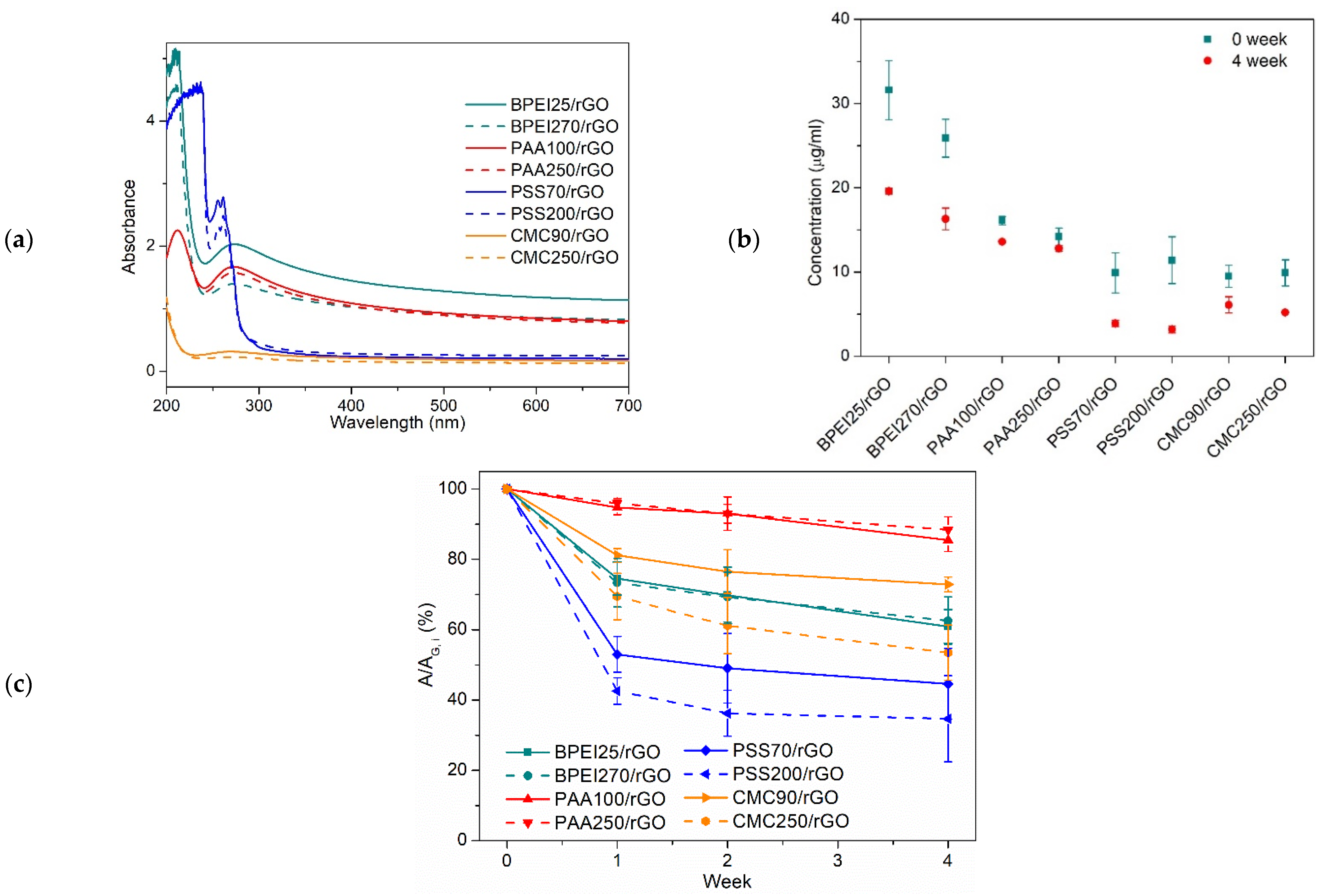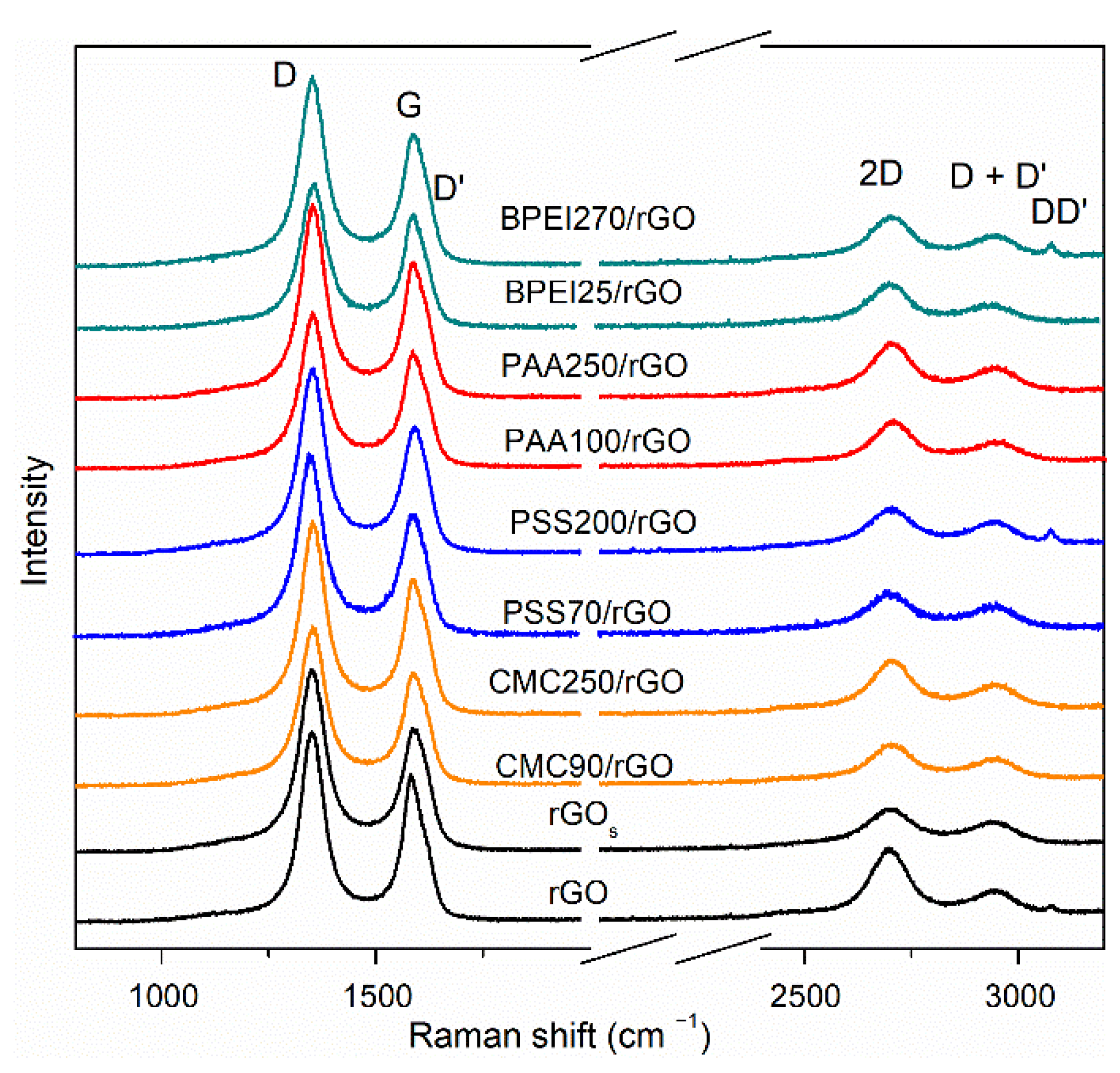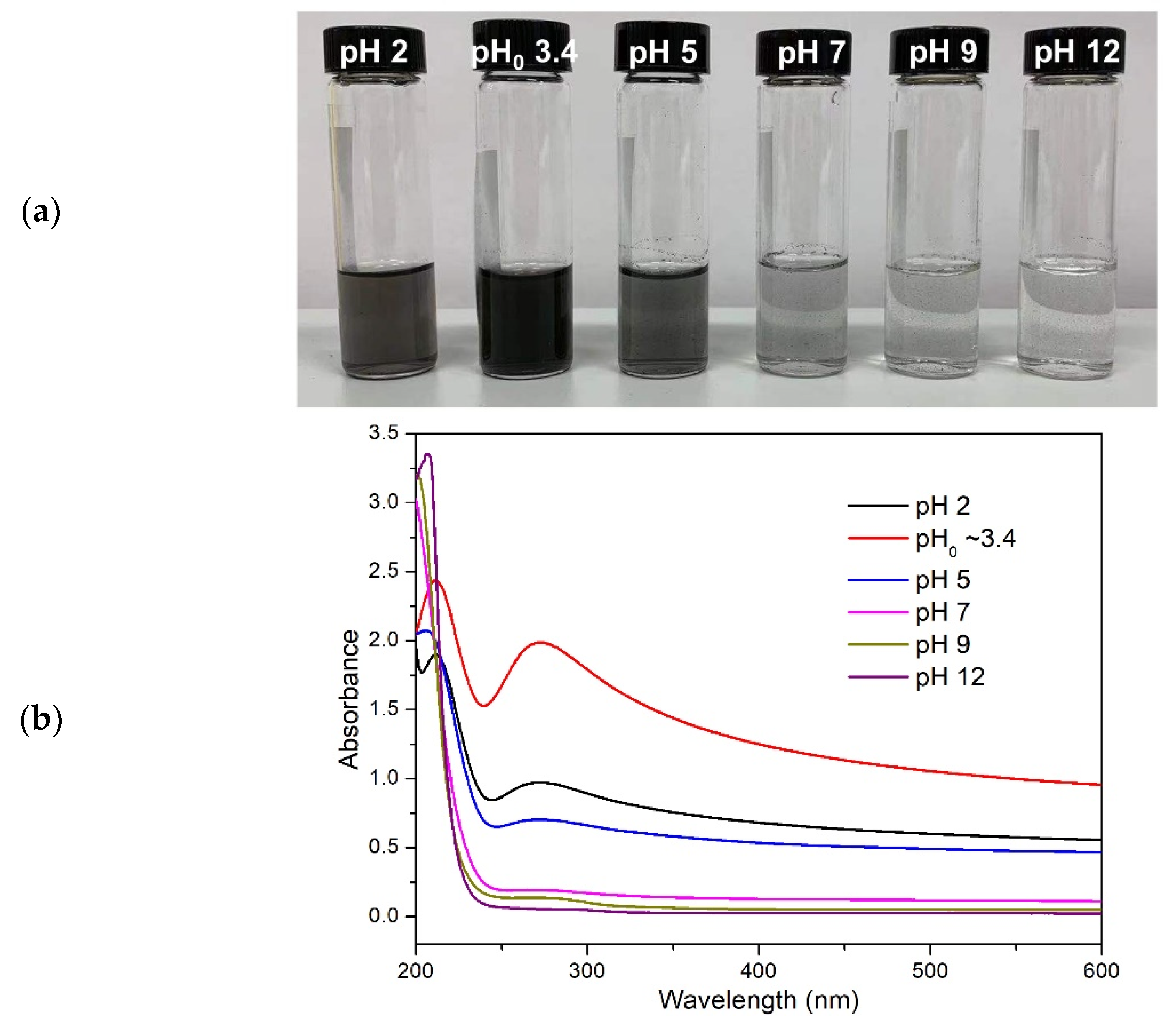Polyelectrolytes Enabled Reduced Graphite Oxide Water Dispersions: Effects of the Structure, Molecular Weight, and Charge Density
Abstract
1. Introduction
2. Materials and Methods
2.1. Materials
2.2. Preparation of PE/rGO Dispersions and Films
2.3. Characterization
3. Results and Discussion
3.1. Dispersion and Stability of rGO in Polyelectrolyte Solutions
3.1.1. Visual Observation
3.1.2. UV-vis Characterization
3.2. Quantification of PE Adsorbed to rGO
3.3. Size and Defectiveness of Suspended rGO
3.4. Interaction between PE and rGO
3.4.1. Charge Density of PAA and BPEI
3.4.2. CMC and PSS
4. Conclusions
Supplementary Materials
Author Contributions
Funding
Data Availability Statement
Acknowledgments
Conflicts of Interest
References
- Li, X.; Yu, J.; Wageh, S.; Al-Ghamdi, A.A.; Xie, J. Graphene in Photocatalysis: A Review. Small 2016, 12, 6640–6696. [Google Scholar] [CrossRef] [PubMed]
- Papageorgiou, D.G.; Kinloch, I.A.; Young, R.J. Mechanical properties of graphene and graphene-based nanocomposites. Prog. Mater. Sci. 2017, 90, 75–127. [Google Scholar] [CrossRef]
- Nguyen, B.H.; Nguyen, V.H. Promising applications of graphene and graphene-based nanostructures. Adv. Nat. Sci. Nanosci. Nanotechnol. 2016, 7, 023002. [Google Scholar] [CrossRef]
- Liu, J.; Wang, F.; Zhang, L.; Fang, X.; Zhang, Z. Thermodynamic properties and thermal stability of ionic liquid-based nanofluids containing graphene as advanced heat transfer fluids for medium-to-high-temperature applications. Renew. Energy 2014, 63, 519–523. [Google Scholar] [CrossRef]
- Lee, T.; Min, S.H.; Gu, M.; Jung, Y.K.; Lee, W.; Lee, J.U.; Seong, D.G.; Kim, B.-S. Layer-by-Layer Assembly for Graphene-Based Multilayer Nanocomposites: Synthesis and Applications. Chem. Mater. 2015, 27, 3785–3796. [Google Scholar] [CrossRef]
- Sham, A.Y.; Notley, S.M. Graphene-polyelectrolyte multilayer film formation driven by hydrogen bonding. J. Colloid Interface Sci. 2015, 456, 32–41. [Google Scholar] [CrossRef]
- Hu, K.; Kulkarni, D.D.; Choi, I.; Tsukruk, V.V. Graphene-polymer nanocomposites for structural and functional applications. Prog. Polym. Sci. 2014, 39, 1934–1972. [Google Scholar] [CrossRef]
- Johnson, D.W.; Dobson, B.P.; Coleman, K.S. A manufacturing perspective on graphene dispersions. Curr. Opin. Colloid Interface Sci. 2015, 20, 367–382. [Google Scholar] [CrossRef]
- Artur Ciesielski, P.S. Graphene via sonication assisted liquid-phase. R. Soc. Chem. 2014, 43, 381–398. [Google Scholar] [CrossRef] [PubMed]
- Bhuyan, M.S.A.; Uddin, M.N.; Islam, M.M.; Bipasha, F.A.; Hossain, S.S. Synthesis of graphene. Int. Nano Lett. 2016, 6, 65–83. [Google Scholar] [CrossRef]
- An, X.; Simmons, T.; Shah, R.; Wolfe, C.; Lewis, K.M.; Washington, M.; Nayak, S.K.; Talapatra, S.; Kar, S. Stable aqueous dispersions of noncovalently functionalized graphene from graphite and their multifunctional high-performance applications. Nano Lett. 2010, 10, 4295–4301. [Google Scholar] [CrossRef] [PubMed]
- Khan, U.; O’Neill, A.; Lotya, M.; De, S.; Coleman, J.N. High-concentration solvent exfoliation of graphene. Small 2010, 6, 864–871. [Google Scholar] [CrossRef] [PubMed]
- Guardia, L.; Fernández-Merino, M.J.; Paredes, J.I.; Fernández, P.-S.; Villar-Rodil, S.; Martínez-Alonso, A.; Tascón, J.M.D. High-throughput production of pristine graphene in an aqueous dispersion assisted by non-ionic surfactants. Carbon 2011, 49, 1653–1662. [Google Scholar] [CrossRef]
- Yu, W.; Sisi, L.; Haiyan, Y.; Jie, L. Progress in the functional modification of graphene/graphene oxide: A review. RSC Adv. 2020, 10, 15328–15345. [Google Scholar] [CrossRef]
- Texter, J. Graphene dispersions. Curr. Opin. Colloid Interface Sci. 2014, 19, 163–174. [Google Scholar] [CrossRef]
- Georgakilas, V.; Tiwari, J.N.; Kemp, K.C.; Perman, J.A.; Bourlinos, A.B.; Kim, K.S.; Zboril, R. Noncovalent Functionalization of Graphene and Graphene Oxide for Energy Materials, Biosensing, Catalytic, and Biomedical Applications. Chem. Rev. 2016, 116, 5464–5519. [Google Scholar] [CrossRef]
- Chortarea, S.; Kuru, O.C.; Netkueakul, W.; Pelin, M.; Keshavan, S.; Song, Z.; Ma, B.; Gomes, J.; Abalos, E.V.; Luna, L.A.V.; et al. Hazard assessment of abraded thermoplastic composites reinforced with reduced graphene oxide. J. Hazard. Mater. 2022, 435, 129053. [Google Scholar] [CrossRef]
- Narayan, R.; Kim, S.O. Surfactant mediated liquid phase exfoliation of graphene. Nano Converg. 2015, 2, 20. [Google Scholar] [CrossRef]
- Feng, B.-B.; Wang, Z.-H.; Suo, W.-H.; Wang, Y.; Wen, J.-C.; Li, Y.-F.; Suo, H.-L.; Liu, M.; Ma, L. Performance of graphene dispersion by using mixed surfactants. Mater. Res. Express 2020, 7, 095009. [Google Scholar] [CrossRef]
- Coleman, J.N. Liquid Exfoliation of Defect-Free Graphene. Acc. Chem. Res. 2013, 46, 14–22. [Google Scholar] [CrossRef]
- Mateos, R.; Vera, S.; Valiente, M.; Diez-Pascual, A.M.; Andres, M.P.S. Comparison of Anionic, Cationic and Nonionic Surfactants as Dispersing Agents for Graphene Based on the Fluorescence of Riboflavin. Nanomaterials 2017, 7, 403. [Google Scholar] [CrossRef]
- Parviz, D.; Das, S.; Ahmed, H.S.T.; Irin, F.; Bhattacharia, S.; Green, M.J. Dispersions of Non-Covalently functionlized graphene with minimal stabilizer. ACS Nano 2012, 6, 8857–8867. [Google Scholar] [CrossRef] [PubMed]
- Schlierf, A.; Yang, H.; Gebremedhn, E.; Treossi, E.; Ortolani, L.; Chen, L.; Minoia, A.; Morandi, V.; Samorì, P.; Casiraghi, C.; et al. Nanoscale insight into the exfoliation mechanism of graphene with organic dyes: Effect of charge, dipole and molecular structure. Nanoscale 2013, 5, 4205–4216. [Google Scholar] [CrossRef] [PubMed]
- Cao, M.; Fu, A.; Wang, Z.; Liu, J.; Kong, N.; Zong, X.; Liu, H.; Gooding, J.J. Electrochemical and Theoretical Study of π–π Stacking Interactions between Graphitic Surfaces and Pyrene Derivatives. J. Phys. Chem. C 2014, 118, 2650–2659. [Google Scholar] [CrossRef]
- McCoy, T.M.; De Campo, L.; Sokolova, A.V.; Grillo, I.; Izgorodina, E.I.; Tabor, R.F. Bulk properties of aqueous graphene oxide and reduced graphene oxide with surfactants and polymers adsorption and stability. Phys. Chem. Chem. Phys. 2018, 20, 16801–16816. [Google Scholar] [CrossRef] [PubMed]
- Yoon, S.; In, I. Role of poly(N-vinyl-2-pyrrolidone) as stabilizer for dispersion of graphene via hydrophobic interaction. J. Mater. Sci. 2010, 46, 1316–1321. [Google Scholar] [CrossRef]
- Zhao, X.; Xu, Z.; Xie, Y.; Zheng, B.; Kou, L.; Gao, C. Polyelectrolyte-stabilized graphene oxide liquid crystals against salt, pH, and serum. Langmuir ACS J. Surf. Colloids 2014, 30, 3715–3722. [Google Scholar] [CrossRef]
- Rani, A.; Oh, K.A.; Koo, H.; Lee, H.j.; Park, M. Multilayer films of cationic graphene-polyelectrolytes and anionic graphene-polyelectrolytes fabricated using layer-by-layer self-assembly. Appl. Surf. Sci. 2011, 257, 4982–4989. [Google Scholar] [CrossRef]
- Du, F.P.; Wang, J.J.; Tang, C.Y.; Tsui, C.P.; Zhou, X.P.; Xie, X.L.; Liao, Y.G. Water-soluble graphene grafted by poly(sodium 4-styrenesulfonate) for enhancement of electric capacitance. Nanotechnology 2012, 23, 475704. [Google Scholar] [CrossRef]
- Griffith, A.; Notley, S.M. pH dependent stability of aqueous suspensions of graphene with adsorbed weakly ionisable cationic polyelectrolyte. J. Colloid Interface Sci. 2012, 369, 210–215. [Google Scholar] [CrossRef]
- Fang, M.; Long, J.; Zhao, W.; Wang, L.; Chen, G. pH-Responsive chitosan-mediated graphene dispersions. Langmuir ACS J. Surf. Colloids 2010, 26, 16771–16774. [Google Scholar] [CrossRef] [PubMed]
- Cai, X.; Lin, M.; Tan, S.; Mai, W.; Zhang, Y.; Liang, Z.; Lin, Z.; Zhang, X. The use of polyethyleneimine-modified reduced graphene oxide as a substrate for silver nanoparticles to produce a material with lower cytotoxicity and long-term antibacterial activity. Carbon 2012, 50, 3407–3415. [Google Scholar] [CrossRef]
- Liu, J.; Tao, L.; Yang, W.; Li, D.; Boyer, C.; Wuhrer, R.; Braet, F.; Davis, T.P. Synthesis, characterization, and multilayer assembly of pH sensitive graphene-polymer nanocomposites. Langmuir ACS J. Surf. Colloids 2010, 26, 10068–10075. [Google Scholar] [CrossRef] [PubMed]
- Zheng, X.; Xu, Q.; Li, J.; Li, L.; Wei, J. High-throughput, direct exfoliation of graphite to graphene via a cooperation of supercritical CO2 and pyrene-polymers. RSC Adv. 2012, 2, 10632. [Google Scholar] [CrossRef]
- Peng, D.; Zhang, J.; Qin, D.; Chen, J.; Shan, D.; Lu, X. An electrochemical sensor based on polyelectrolyte-functionalized graphene for detection of 4-nitrophenol. J. Electroanal. Chem. 2014, 734, 1–6. [Google Scholar] [CrossRef]
- Wang, X.; Liu, X.; Yuan, H.; Liu, H.; Liu, C.; Li, T.; Yan, C.; Yan, X.; Shen, C.; Guo, Z. Non-covalently functionalized graphene strengthened poly(vinyl alcohol). Mater. Des. 2018, 139, 372–379. [Google Scholar] [CrossRef]
- Ma, J.; Cai, P.; Qi, W.; Kong, D.; Wang, H. The layer-by-layer assembly of polyelectrolyte functionalized graphene sheets: A potential tool for biosensing. Colloids Surf. A Physicochem. Eng. Asp. 2013, 426, 6–11. [Google Scholar] [CrossRef]
- Li, X.; Zhong, A.; Wei, S.; Luo, X.; Liang, Y.; Zhu, Q. Polyelectrolyte functionalized gold nanoparticles-reduced graphene oxide nanohybrid for electrochemical determination of aminophenol isomers. Electrochim. Acta 2015, 164, 203–210. [Google Scholar] [CrossRef]
- Yan, H.; Wu, Y.; Luo, X.; Jiao, L.; Zhu, C.; Du, D. Tuning polyelectrolyte-graphene interaction for enhanced electrochemical nonenzymatic hydrogen peroxide sensing. Anal. Chim. Acta 2019, 1049, 98–104. [Google Scholar] [CrossRef]
- Tong, Z.; Xu, M.; Li, Q.; Liu, C.; Wang, Y.; Sha, J. Polyelectrolyte-functionalized reduced graphene oxide wrapped helical POMOF nanocomposites for bioenzyme-free colorimetric biosensing. Talanta 2020, 220, 121373. [Google Scholar] [CrossRef]
- Viinikanoja, A.; Kauppila, J.; Damlin, P.; Mäkilä, E.; Leiro, J.; Ääritalo, T.; Lukkari, J. Interactions between graphene sheets and ionic molecules used for the shear-assisted exfoliation of natural graphite. Carbon 2014, 68, 195–209. [Google Scholar] [CrossRef]
- Lu, J.; Do, I.; Fukushima, H.; Lee, I.; Drzal, L.T. Stable Aqueous Suspension and Self-Assembly of Graphite Nanoplatelets Coated with Various Polyelectrolytes. J. Nanomater. 2010, 2010, 1–11. [Google Scholar] [CrossRef]
- Liu, H.; Bandyopadhyay, P.; Kshetri, T.; Kim, N.H.; Ku, B.-C.; Moon, B.; Lee, J.H. Layer-by-layer assembled polyelectrolyte-decorated graphene multilayer film for hydrogen gas barrier application. Compos. Part B Eng. 2017, 114, 339–347. [Google Scholar] [CrossRef]
- Duan, Y.; Wang, C.; Zhao, M.; Vogt, B.D.; Zacharia, N.S. Mechanical properties of bulk graphene oxide/poly(acrylic acid)/poly(ethylenimine) ternary polyelectrolyte complex. Soft Matter 2018, 14, 4396–4403. [Google Scholar] [CrossRef] [PubMed]
- Maddalena, L.; Benselfelt, T.; Gomez, J.; Hamedi, M.M.; Fina, A.; Wagberg, L.; Carosio, F. Polyelectrolyte-Assisted Dispersions of Reduced Graphite Oxide Nanoplates in Water and Their Gas-Barrier Application. ACS Appl. Mater. Interfaces 2021, 13, 43301–43313. [Google Scholar] [CrossRef] [PubMed]
- Colonna, S.; Battegazzore, D.; Eleuteri, M.; Arrigo, R.; Fina, A. Properties of Graphene-Related Materials Controlling the Thermal Conductivity of Their Polymer Nanocomposites. Nanomaterials 2020, 10, 2167. [Google Scholar] [CrossRef] [PubMed]
- Dickhaus, B.N.; Priefer, R. Determination of polyelectrolyte pKa values using surface-to-air tension measurements. Colloids Surf. A: Physicochem. Eng. Asp. 2016, 488, 15–19. [Google Scholar] [CrossRef]
- Vasilieva, E.; Ibragimova, A.; Lukashenko, S.; Konovalov, A.; Zakharova, L. Mixed self-assembly of polyacrylic acid and oppositely charged gemini surfactants differing in the structure of head group. Fluid Phase Equilibria 2014, 376, 172–180. [Google Scholar] [CrossRef]
- Griffiths, P.C.; Paul, A.; Fallis, I.A.; Wellappili, C.; Murphy, D.M.; Jenkins, R.; Waters, S.J.; Nilmini, R.; Heenan, R.K.; King, S.M. Derivatizing weak polyelectrolytes--solution properties, self-aggregation, and association with anionic surfaces of hydrophobically modified poly(ethylene imine). J. Colloid Interface Sci. 2007, 314, 460–469. [Google Scholar] [CrossRef]
- Bellettini, I.C.; Nandi, L.G.; Eising, R.; Domingos, J.B.; Machado, V.G.; Minatti, E. Properties of aqueous solutions of hydrophobically modified polyethylene imines in the absence and presence of sodium dodecylsulfate. J. Colloid Interface Sci. 2012, 370, 94–101. [Google Scholar] [CrossRef]
- Guillot, S.; Delsanti, M.; Désert, S.; Langevin, D. Surfactant-Induced Collapse of Polymer Chains and Monodisperse Growth of Aggregates near the Precipitation Boundary in Carboxymethylcellulose−DTAB Aqueous Solutions. Langmuir ACS J. Surf. Colloids 2003, 19, 230–237. [Google Scholar] [CrossRef]
- Lee, B.-B.; Chan, E.-S.; Ravindra, P.; Khan, T.A. Surface tension of viscous biopolymer solutions measured using the du Nouy ring method and the drop weight methods. Polym. Bull. 2012, 69, 471–489. [Google Scholar] [CrossRef]
- Weber, F.E.; Taillie, S.A.; Stauffer, K.R. Functional characteristics of mustard mucilage. J. Food Sci. 1974, 39, 461–466. [Google Scholar] [CrossRef]
- Okubo, T. Surface tension of synthetic polyelectrolyte solutions at the air-water interface. J. Colloid Interface Sci. 1988, 125, 386–398. [Google Scholar] [CrossRef]
- Li, L.; Hsieh, Y.-L. Ultra-fine polyelectrolyte fibers from electrospinning of poly(acrylic acid). Polymer 2005, 46, 5133–5139. [Google Scholar] [CrossRef]
- Young, T. An essay on the cohesion of fluids. Philos. Trans. R. Soc. Lond. 1805, 95, 65–87. [Google Scholar]
- Perrozzi, F.; Croce, S.; Treossi, E.; Palermo, V.; Santucci, S.; Fioravanti, G.; Ottaviano, L. Reduction dependent wetting properties of graphene oxide. Carbon 2014, 77, 473–480. [Google Scholar] [CrossRef]
- Wang, S.; Zhang, Y.; Abidi, N.; Cabrales, L. Wettability and surface free energy of graphene films. Langmuir ACS J. Surf. Colloids 2009, 25, 11078–11081. [Google Scholar] [CrossRef]
- Li, D.; Neumann, A.W. Contact angles on hydrophobic solid surfaces and their interpretation. J. Colloid Interface Sci. 1992, 148, 190–200. [Google Scholar] [CrossRef]
- Lotya, M.; King, P.J.; Khan, U.; De, S.; Coleman, J.N. High-Concentration, Surfactant Stabilized Graphene Dispersions. CS Nano 2010, 4, 3155–3162. [Google Scholar] [CrossRef]
- Cai, M.; Thorpe, D.; Adamson, D.H.; Schniepp, H.C. Methods of graphite exfoliation. J. Mater. Chem. 2012, 22, 24992. [Google Scholar] [CrossRef]
- Chen, D.; Li, L.; Guo, L. An environment-friendly preparation of reduced graphene oxide nanosheets via amino acid. Nanotechnology 2011, 22, 325601. [Google Scholar] [CrossRef]
- Shtein, M.; Pri-Bar, I.; Varenik, M.; Regev, O. Characterization of graphene-nanoplatelets structure via thermogravimetry. Anal. Chem. 2015, 87, 4076–4080. [Google Scholar] [CrossRef]
- Zhong, M.; Liu, Y.-T.; Xie, X.-M. Self-healable, super tough graphene oxide/poly(acrylic acid) nanocomposite hydrogels facilitated by dual cross-linking effects through dynamic ionic interactions. J. Mater. Chem. B 2015, 3, 4001–4008. [Google Scholar] [CrossRef] [PubMed]
- Layek, R.K.; Kundu, A.; Nandi, A.K. High-Performance Nanocomposites of Sodium Carboxymethylcellulose and Graphene Oxide. Macromol. Mater. Eng. 2013, 298, 1166–1175. [Google Scholar] [CrossRef]
- Wang, J.; Feng, M.; Zhan, H. Preparation, characterization, and nonlinear optical properties of graphene oxide-carboxymethyl cellulose composite films. Opt. Laser Technol. 2014, 57, 84–89. [Google Scholar] [CrossRef]
- Govindaiah, P.; Kim, Y.S.; Hong, J.K.; Kim, J.H.; Cheong, I.W. One-pot synthesis of grafted brush copolymers via a chain-growth radical/oxidative dual polymerization system. RSC Adv. 2015, 5, 93717–93723. [Google Scholar] [CrossRef]
- Lotya, M.; Rakovich, A.; Donegan, J.F.; Coleman, J.N. Measuring the lateral size of liquid-exfoliated nanosheets with dynamic light scattering. Nanotechnology 2013, 24, 265703. [Google Scholar] [CrossRef] [PubMed]
- Eaton, P.; Quaresma, P.; Soares, C.; Neves, C.; de Almeida, M.P.; Pereira, E.; West, P. A direct comparison of experimental methods to measure dimensions of synthetic nanoparticles. Ultramicroscopy 2017, 182, 179–190. [Google Scholar] [CrossRef]
- Amaro-Gahete, J.; Benitez, A.; Otero, R.; Esquivel, D.; Jimenez-Sanchidrian, C.; Morales, J.; Caballero, A.; Romero-Salguero, F.J. A Comparative Study of Particle Size Distribution of Graphene Nanosheets Synthesized by an Ultrasound-Assisted Method. Nanomaterials 2019, 9, 152. [Google Scholar] [CrossRef] [PubMed]
- Göldel, A.; Marmur, A.; Kasaliwal, G.R.; Pötschke, P.; Heinrich, G. Shape-Dependent Localization of Carbon Nanotubes and Carbon Black in an Immiscible Polymer Blend during Melt Mixing. Macromolecules 2011, 44, 6094–6102. [Google Scholar] [CrossRef]
- Backes, C.; Abdelkader, A.M.; Alonso, C.; Andrieux-Ledier, A.; Arenal, R.; Azpeitia, J.; Balakrishnan, N.; Banszerus, L.; Barjon, J.; Bartali, R.; et al. Production and processing of graphene and related materials. 2D Mater. 2020, 7, 022001. [Google Scholar] [CrossRef]
- Ferrari, A.C.; Robertson, J. Interpretation of Raman spectra of disordered and amorphous carbon. Phys. Rev. B 2000, 61, 14095–14107. [Google Scholar] [CrossRef]
- Ferrari, A.C.; Basko, D.M. Raman spectroscopy as a versatile tool for studying the properties of graphene. Nat. Nanotechnol. 2013, 8, 235–246. [Google Scholar] [CrossRef]
- Muzyka, R.; Drewniak, S.; Pustelny, T.; Chrubasik, M.; Gryglewicz, G. Characterization of Graphite Oxide and Reduced Graphene Oxide Obtained from Different Graphite Precursors and Oxidized by Different Methods Using Raman Spectroscopy. Materials 2018, 11, 1050. [Google Scholar] [CrossRef] [PubMed]
- Wu, J.B.; Lin, M.L.; Cong, X.; Liu, H.N.; Tan, P.H. Raman spectroscopy of graphene-based materials and its applications in related devices. Chem. Soc. Rev. 2018, 47, 1822–1873. [Google Scholar] [CrossRef]
- Chee, S.Y.; Poh, H.L.; Chua, C.K.; Sanek, F.; Sofer, Z.; Pumera, M. Influence of parent graphite particle size on the electrochemistry of thermally reduced graphene oxide. Phys. Chem. Chem. Phys. PCCP 2012, 14, 12794–12799. [Google Scholar] [CrossRef]
- Liu, H.; Kuila, T.; Kim, N.H.; Ku, B.-C.; Lee, J.H. In situ synthesis of the reduced graphene oxide–polyethyleneimine composite and its gas barrier properties. J. Mater. Chem. A 2013, 1, 3739. [Google Scholar] [CrossRef]
- Jiang, F.; Zhao, W.; Wu, Y.; Wu, Y.; Liu, G.; Dong, J.; Zhou, K. A polyethyleneimine-grafted graphene oxide hybrid nanomaterial: Synthesis and anti-corrosion applications. Appl. Surf. Sci. 2019, 479, 963–973. [Google Scholar] [CrossRef]
- Konkena, B.; Vasudevan, S. Understanding Aqueous Dispersibility of Graphene Oxide and Reduced Graphene Oxide through pKa Measurements. J. Phys. Chem. Lett. 2012, 3, 867–872. [Google Scholar] [CrossRef]
- Ong, B.C.; Leong, Y.K.; Chen, S.B. Interparticle forces in spherical monodispersed silica dispersions: Effects of branched polyethylenimine and molecular weight. J. Colloid Interface Sci. 2009, 337, 24–31. [Google Scholar] [CrossRef]
- Schneider, M.; Brinkmann, M.; Möhwald, H. Adsorption of Polyethylenimine on Graphite An Atomic Force. Macromolecules 2003, 36, 9510–9518. [Google Scholar] [CrossRef]
- Clasen, C.; Kulicke, W.M. Determination of viscoelastic and rheo-optical material functions of water-soluble cellulose derivatives. Prog. Polym. Sci. 2001, 26, 1839–1919. [Google Scholar] [CrossRef]
- Lopez, C.G.; Rogers, S.E.; Colby, R.H.; Graham, P.; Cabral, J.T. Structure of Sodium Carboxymethyl Cellulose Aqueous Solutions: A SANS and Rheology Study. J. Polym. Sci. Part B Polym. Phys. 2015, 53, 492–501. [Google Scholar] [CrossRef] [PubMed]
- Lee, J.-H.; Paik, U.; Hackley, V.A.; Choi, Y.-M. Effect of Carboxymethyl Cellulose on Aqueous Processing of Natural Graphite Negative Electrodes and their Electrochemical Performance for Lithium Batteries. J. Electrochem. Soc. 2005, 152, A1763. [Google Scholar] [CrossRef]
- Liang, Y.; Qu, C.; Yang, R.; Qu, L.; Li, J. Molecularly imprinted electrochemical sensor for daidzein recognition and detection based on poly(sodium 4-styrenesulfonate) functionalized graphene. Sens. Actuators B Chem. 2017, 251, 542–550. [Google Scholar] [CrossRef]







| Temperature (°C) | Concentration (w/v%) | Surface Tension (mN/m) | Method | |
|---|---|---|---|---|
| PAA | 25 | 0.07 | ~59 | Du Nouy ring method (Brittany et al. [47]) |
| 25 | 0.1 | ~63 | Du Nouy ring method (Elmira et al. [48]) | |
| BPEI | 25 | 0.1 | ~71 | Du Nouy ring method (Peter et al. [49]) |
| 25 | 0.1 | ~72 | Du Nouy ring method (Ismael et al. [50]) | |
| CMC | 20/25 | 0.1 | ~72 | Wihelmy method/axisymmetric drop shape analysis method (Samuel et al. [51]) |
| 25 | 0.5 | ~75 ~71 ~71 | Du Nouy ring method, Harkins-Brown (HB) drop weight method, Lee-Chan-Pogaku (LCP) drop weight method (Boon et al. [52]) | |
| 0.25 | ~69 | Du Nouy ring method (Weber et al. [53]) | ||
| PSS | 25 | 0.1 | ~72.5 | Wihelmy method (Tsuneo et al. [54]) |
| Sample | Weight Residual (%) | rGO Weight Percentage wG (%) | PE Weight Percentage (1−wG) (%) |
|---|---|---|---|
| BPEI25/rGO | 76.1 | 80.1 | 19.9 |
| BPEI270/rGO | 75.4 | 79.3 | 20.7 |
| PAA100/rGO | 76.3 | 76.4 | 23.6 |
| PAA250/rGO | 76.4 | 77.1 | 22.9 |
| PSS70/rGO | 86.7 | 86.0 | 14.0 |
| PSS200/rGO | 84.6 | 82.4 | 17.6 |
| CMC90/rGO | 70.2 | 63.5 | 36.5 |
| CMC250/rGO | 75.6 | 67.3 | 32.7 |
Publisher’s Note: MDPI stays neutral with regard to jurisdictional claims in published maps and institutional affiliations. |
© 2022 by the authors. Licensee MDPI, Basel, Switzerland. This article is an open access article distributed under the terms and conditions of the Creative Commons Attribution (CC BY) license (https://creativecommons.org/licenses/by/4.0/).
Share and Cite
Jiang, T.; Maddalena, L.; Gomez, J.; Carosio, F.; Fina, A. Polyelectrolytes Enabled Reduced Graphite Oxide Water Dispersions: Effects of the Structure, Molecular Weight, and Charge Density. Polymers 2022, 14, 4165. https://doi.org/10.3390/polym14194165
Jiang T, Maddalena L, Gomez J, Carosio F, Fina A. Polyelectrolytes Enabled Reduced Graphite Oxide Water Dispersions: Effects of the Structure, Molecular Weight, and Charge Density. Polymers. 2022; 14(19):4165. https://doi.org/10.3390/polym14194165
Chicago/Turabian StyleJiang, Tianhui, Lorenza Maddalena, Julio Gomez, Federico Carosio, and Alberto Fina. 2022. "Polyelectrolytes Enabled Reduced Graphite Oxide Water Dispersions: Effects of the Structure, Molecular Weight, and Charge Density" Polymers 14, no. 19: 4165. https://doi.org/10.3390/polym14194165
APA StyleJiang, T., Maddalena, L., Gomez, J., Carosio, F., & Fina, A. (2022). Polyelectrolytes Enabled Reduced Graphite Oxide Water Dispersions: Effects of the Structure, Molecular Weight, and Charge Density. Polymers, 14(19), 4165. https://doi.org/10.3390/polym14194165








